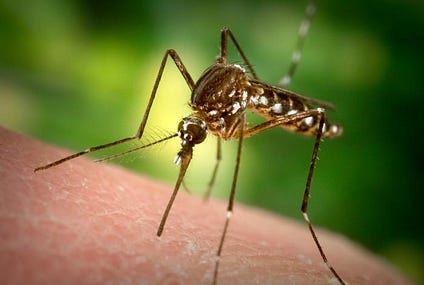Bangladesh reports more than 1,100 dengue cases in past 24 hours – Outbreak News Today

Report on Dengue Fever Outbreak in Bangladesh and Implications for Sustainable Development Goals
1. Executive Summary
This report details the ongoing dengue fever outbreak in Bangladesh, based on data released by the Directorate General of Health Services (DGHS). The escalating public health crisis presents significant challenges to the nation’s progress towards several key Sustainable Development Goals (SDGs), particularly SDG 3 (Good Health and Well-being), SDG 11 (Sustainable Cities and Communities), and SDG 13 (Climate Action). The report outlines the current epidemiological situation, highlights the strain on public health infrastructure, and connects the outbreak’s impact to the broader 2030 Agenda for Sustainable Development.
2. Current Epidemiological Situation
The DGHS has reported a significant surge in dengue fever cases, indicating a severe public health challenge that directly impacts SDG 3, which aims to ensure healthy lives and promote well-being for all.
- Daily Hospitalizations: 1,143 new hospitalizations were recorded in the last 24-hour reporting period.
- Monthly Infections: October has seen the highest monthly total of cases this year, with 18,098 reported infections.
- Cumulative Cases: The total number of dengue cases has reached 65,440 as of October 26.
- Fatalities: An additional four deaths were reported, bringing the total fatality count for the year to 263. This mortality rate undermines Target 3.3 of the SDGs, which is to end the epidemics of communicable diseases by 2030.
3. Geographic Distribution and Urban Health Challenges (SDG 11)
The concentration of cases in urban centers highlights critical issues related to urban planning and public health infrastructure, directly relevant to SDG 11 (Sustainable Cities and Communities). Inadequate waste management and water storage systems in densely populated areas create breeding grounds for mosquitoes, exacerbating the outbreak.
- Dhaka Division: Remains the epicenter with 282 new cases.
- Dhaka City Corporations:
- Dhaka North City Corporation (DNCC): 165 cases
- Dhaka South City Corporation (DSCC): 154 cases
- Other Affected Regions: Barishal division reported a significant number of cases (186), indicating a widespread national issue.
4. Broader Implications for Sustainable Development
The dengue outbreak extends beyond a health crisis, affecting multiple facets of sustainable development.
- SDG 3 (Good Health and Well-being): The outbreak overwhelms healthcare facilities, diverts resources from other essential health services, and increases mortality from a preventable disease, directly hindering progress on Target 3.3.
- SDG 11 (Sustainable Cities and Communities): The high incidence in cities like Dhaka underscores the urgent need for improved urban sanitation, waste management, and public health infrastructure as outlined in Target 11.6.
- SDG 1 (No Poverty) & SDG 8 (Decent Work and Economic Growth): Illness from dengue leads to loss of income and productivity. The cost of treatment can push vulnerable households into poverty, creating a vicious cycle that impedes economic progress.
- SDG 13 (Climate Action): Changing climate patterns, including increased rainfall and higher temperatures, are known to expand the habitat of dengue-carrying mosquitoes and prolong transmission seasons. This outbreak serves as a critical reminder of the health-related impacts of climate change, emphasizing the need for integrated climate adaptation strategies.
5. Recommendations for an SDG-Aligned Response
To mitigate the current outbreak and build long-term resilience, a multi-sectoral approach aligned with the SDGs is imperative.
- Strengthen Public Health Surveillance (SDG 3): Enhance early warning systems and response mechanisms to manage outbreaks effectively and prevent epidemics.
- Invest in Urban Infrastructure (SDG 11): Prioritize investments in sustainable waste management, clean water, and sanitation systems in urban and peri-urban areas to eliminate mosquito breeding sites.
- Integrate Climate and Health Policies (SDG 13): Develop and implement national health strategies that account for climate change risks, including the expansion of vector-borne diseases.
- Community Engagement and Education (SDG 3): Launch sustained public awareness campaigns on dengue prevention, symptom recognition, and the importance of seeking timely medical care.
1. Which SDGs are addressed or connected to the issues highlighted in the article?
SDG 3: Good Health and Well-being
- The article focuses entirely on a public health crisis: a dengue fever outbreak in Bangladesh. It details the impact of the disease on the population’s health, including hospitalizations, total cases, and deaths. This directly relates to the core mission of SDG 3, which is to ensure healthy lives and promote well-being for all at all ages.
2. What specific targets under those SDGs can be identified based on the article’s content?
Target 3.3: By 2030, end the epidemics of AIDS, tuberculosis, malaria and neglected tropical diseases and combat hepatitis, water-borne diseases and other communicable diseases.
- Dengue is a mosquito-borne communicable disease. The article’s report on the high number of cases (“total dengue cases in the country to 65,440”) and the increasing rate of infection (“So far in October, 18,098 cases were reported, the most of any month this year”) clearly indicates an ongoing epidemic that this target aims to combat.
Target 3.d: Strengthen the capacity of all countries, in particular developing countries, for early warning, risk reduction and management of national and global health risks.
- The dengue outbreak described in the article represents a significant national health risk for Bangladesh. The data on hospitalizations (“1,143 new dengue fever hospitalizations in the past 24 hours”) and fatalities (“four additional dengue deaths were reported today, bringing the the fatality total to 263”) highlight the challenges in managing this health crisis and underscore the importance of strengthening the country’s capacity to handle such outbreaks.
3. Are there any indicators mentioned or implied in the article that can be used to measure progress towards the identified targets?
Indicators for Target 3.3
- Incidence of Dengue: The article provides raw data that serves as a direct measure of the disease’s incidence. Specific figures like “total dengue cases in the country to 65,440” and “1,143 new dengue fever hospitalizations in the past 24 hours” are key metrics for tracking the scale of the epidemic.
- Number of people requiring interventions against communicable diseases: The report of “1,143 new dengue fever hospitalizations” is a direct indicator of the number of people whose illness is severe enough to require significant medical intervention, which is a core concern of controlling communicable diseases.
Indicators for Target 3.d
- Mortality Rate Attributed to Dengue: The article provides the data needed to assess the severity and management of the health risk. It states there have been “263” deaths out of “65,440” cases in the current outbreak, and “575 people” died from dengue in 2024. This mortality data is a critical indicator of the healthcare system’s capacity to manage the disease and prevent deaths.
4. Table of SDGs, Targets, and Indicators
| SDGs | Targets | Indicators |
|---|---|---|
| SDG 3: Good Health and Well-being | 3.3: End the epidemics of… communicable diseases. |
|
| SDG 3: Good Health and Well-being | 3.d: Strengthen capacity for… management of national and global health risks. |
|
Source: outbreaknewstoday.substack.com
What is Your Reaction?
 Like
0
Like
0
 Dislike
0
Dislike
0
 Love
0
Love
0
 Funny
0
Funny
0
 Angry
0
Angry
0
 Sad
0
Sad
0
 Wow
0
Wow
0
















































:focal(1500,1000)/https://media.globalcitizen.org/a6/9a/a69a4720-d8a1-4715-b596-18738d03c05c/rotary_polio_hero_image.jpg?#)







/countries/sri-lanka/photo-credit---dmc-sri-lanka.tmb-1200v.jpg?sfvrsn=dc298bcc_1#)









![EMJ Microbiology & Infectious Diseases 6 [Supplement 4] 2025 – European Medical Journal](https://www.emjreviews.com/wp-content/uploads/2025/11/EMJ-EACS-Supplement-2025_Web.jpg?#)








